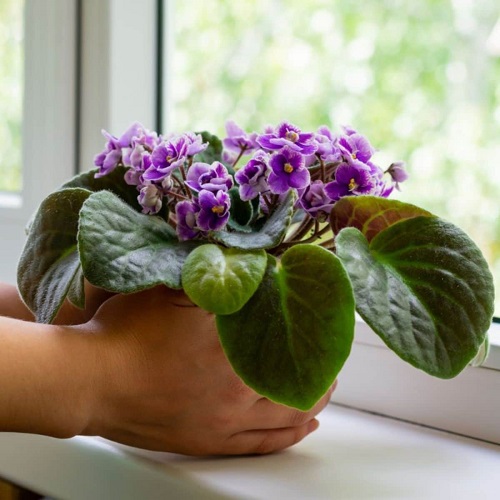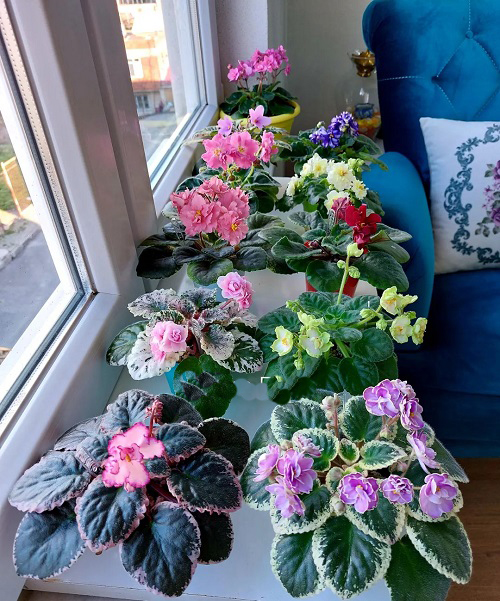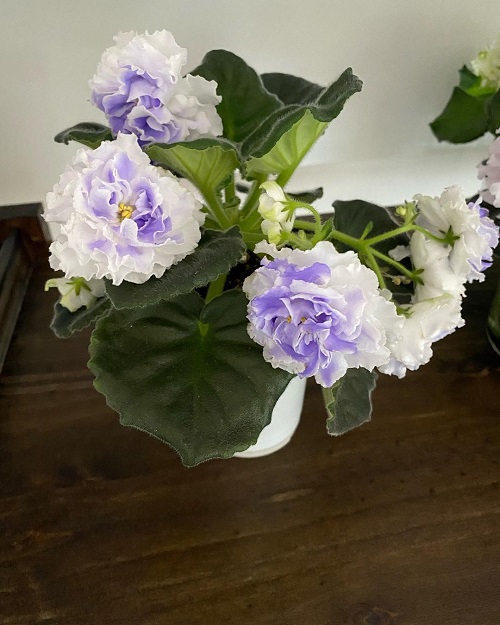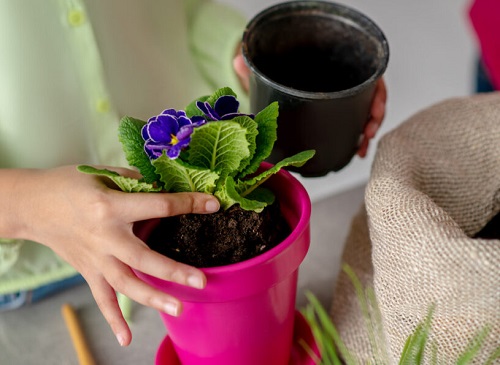Are you frustrated that your plant isn’t blooming? Learn How to Force African Violets to Bloom with top tips!
It can be frustrating to bring home an ornamental plant like the African Violet when it refuses to bloom. Read on to learn everything about How to Force African Violets to Bloom.
Here’s all you need to know about growing African Violets from leaves
How to Force African Violets to Bloom
1. It Needs Light! Lot of It!
African violets require bright, indirect light to bloom. Place them near a north or east-facing window where they can receive sufficient light without being exposed to direct sunlight, which can scorch their delicate leaves. Consider using sheer curtains or blinds to filter the light if it’s too intense.
If your room doesn’t get natural light, then consider providing supplemental lighting using fluorescent grow lights or LED lights.
Position the lights 6-12 inches above the plants and provide 12-16 hours of light per day. This can help compensate for low light conditions and promote earlier blooming.
Here’s all you need to know about growing African Violets indoors
2. Give them Plenty of Humidity

These plants thrive in high-humidity environments. To increase humidity around your African violets, you can place them on a tray filled with pebbles and water.
As the water evaporates, it creates a humid microclimate around the plants. Alternatively, using a humidifier in the room can also be beneficial. Misting the leaves occasionally can also help raise humidity levels.
Here are 10 Ways To Increase Humidity For Houseplants That Work
3. Fertilize Right
African violets benefit from regular fertilization to promote blooming. Look for a fertilizer blend with an N-P-K ratio that emphasizes phosphorus, such as 10-30-20 or 5-10-5.
For African violets, it’s generally recommended to use about ¼ to ½ the strength of the recommended dosage. Do this every 2-4 weeks during the active growing season, which typically occurs in spring and summer.
Reduce or cease fertilization during the winter months when the plant’s growth slows down.
Here are the Best Fruit Peels You Can Use as Fertilizers
Pro Tip: In addition to regular fertilization, you can use a bloom-boosting fertilizer specifically formulated for African violets. These fertilizers contain higher levels of phosphorus, which promotes flower development. Follow the package instructions for application rates and frequency.
4. Keep them Warm

African violets prefer a stable temperature between 65-85°F (18-30°C). Avoid exposing them to extreme temperature fluctuations, drafts, or cold air from air conditioning or heating vents.
Fluctuations in temperature can stress the plants and hinder blooming.
5. Check for Pests or Diseases

- Aphids can distort new growth, cause leaf yellowing, and stunt the overall growth of the plant, potentially affecting flower production.
- Mealybugs can cluster around leaf joints, under leaves, and near the base of the plant, leading to decreased flowering and overall decline.
- Spider mites feed on the plant sap, causing stippling or yellowing of leaves and weakening the plant’s health, which can impact flower production.
- Thrips are slender, winged insects that can cause damage to African violet leaves, leading to distorted growth, silvering or bronzing of leaves, and hindered flower production.
- Botrytis Blight causes brown or grayish patches on leaves, flowers, and stems, often accompanied by a fuzzy mold. Infected plants may experience reduced flower production and overall decline.
- Excessive moisture or poorly draining soil can lead to root rot in African violets. Root rot can cause wilting, yellowing leaves, and overall plant decline, including reduced flowering.
To prevent and manage these issues, it’s important to maintain good plant hygiene, provide proper cultural care, and promptly address any signs of infestation or disease.
Regularly inspect your plants, isolate any affected plants, and treat them with appropriate organic or chemical controls if necessary.
Proper watering practices, adequate airflow, and providing optimal growing conditions will help maintain the health of African violets and promote flowering.
Click here to learn the Amazing Natural Pesticide Recipe that can Kill any Pest
6. Watering Woes
Watering practices can impact flowering in African violet plants.
- Overwatering: Excessive watering and waterlogged soil can lead to root rot, which can negatively impact the health and flowering of African violet plants. When the roots are constantly saturated, they can suffocate and become susceptible to fungal diseases. Root rot can cause wilting, yellowing leaves, and a decline in overall plant vigor, resulting in reduced or no flowers.
Here are Signs of Overwatering & How to Save an Overwatered Plant
- Underwatering: On the other hand, underwatering can also hinder flowering in African violets. These plants require consistent moisture in the root zone to support healthy growth and flower production. When the soil becomes too dry, African violets may experience stress and conserve energy, reducing or ceasing flower production until adequate moisture is provided.
Look out for these 5 Sure Shot Signs of Underwatered Plants
Water the African violet when the top inch of the soil feels dry to the touch. Insert your finger into the soil or use a moisture meter to assess the moisture level.
African violets are sensitive to minerals and chemicals in tap water. To avoid issues, use room-temperature filtered water or allow tap water to sit overnight to dissipate chlorine and other additives.
7. Keep the Plant Slightly Root Bound
African violets tend to bloom more profusely when they are slightly root-bound in their pots. Here’s why:
- Stimulation of Flowering: When the root system of an African violet becomes slightly crowded in the pot, it can stimulate the plant to produce more flowers. The presence of compacted roots signals to the plant that it has reached its maximum capacity in the current pot and that it’s time to focus energy on reproduction, which includes blooming.
- Balanced Growth and Nutrition: A root-bound condition can help maintain a balance between root growth and top growth. It restricts excessive root growth, preventing the plant from becoming overly vegetative and favoring flower production instead. This balance is crucial for promoting healthy and abundant blooms.
- Concentrated Energy: When an African violet is root-bound, it directs its energy towards flowering and blooming rather than extensive root growth. This energy concentration allows the plant to allocate more resources to developing flower buds and supporting floral growth.
Important: Do note that there is a limit to how root-bound an African violet should become. If the root system becomes excessively constricted and crowded, it can lead to root suffocation, poor nutrient uptake, and restricted water absorption. This can negatively impact overall plant health and flowering.
8. Keep on Trimming and Removing Suckers
Trimming and removing suckers from African violet plants can indeed promote better flower production. It helps the plant to:
- Focus Energy on Blooming: African violet suckers compete for nutrients and energy with the main plant, potentially diverting resources away from flower production. Eliminating suckers redirects the plant’s energy towards blooming, allowing it to put more effort into developing and sustaining flowers.
- Enhance Airflow and Light Penetration: Suckers can contribute to overcrowding and compactness in the plant, leading to reduced airflow and limited light penetration. Insufficient airflow can create a humid environment prone to fungal diseases, while limited light can hinder proper photosynthesis. Trimming suckers open up the plant, allowing better air circulation and light exposure, which can positively impact flower development.
- Maintain Compact and Aesthetic Growth: Too much growth and suckers can cause the African violet plant to become bushier and more sprawling. By removing suckers, you can maintain a more compact and aesthetically pleasing plant shape, ensuring that the blooms are displayed prominently.
When trimming and removing suckers, do keep the following points in mind:
- Allow suckers to develop to a reasonable size before removing them. This ensures that they have developed their own root system and are capable of sustaining themselves.
- Use clean and sterilized scissors or pruning shears to trim the suckers. This helps prevent the spread of diseases or infections.
- Cut the sucker as close to the base of the plant as possible without damaging the main stem or roots. Make clean cuts to minimize stress and potential entry points for pests or diseases.
While trimming and removing suckers can benefit African violet flowering, it’s essential to strike a balance and avoid excessive pruning, which can stress the plant.







